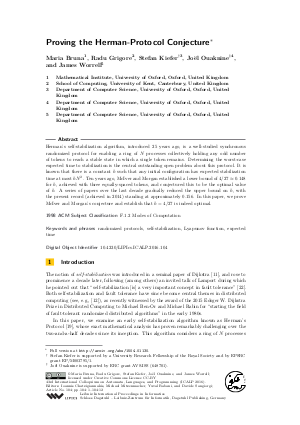Proving the Herman-Protocol Conjecture
Authors Maria Bruna, Radu Grigore, Stefan Kiefer, Joël Ouaknine, James Worrell
-
Part of:
Volume:
43rd International Colloquium on Automata, Languages, and Programming (ICALP 2016)
Part of: Series: Leibniz International Proceedings in Informatics (LIPIcs)
Part of: Conference: International Colloquium on Automata, Languages, and Programming (ICALP) - License:
 Creative Commons Attribution 3.0 Unported license
Creative Commons Attribution 3.0 Unported license
- Publication Date: 2016-08-23
File

PDF
LIPIcs.ICALP.2016.104.pdf
- Filesize: 0.49 MB
- 12 pages
Document Identifiers
Subject Classification
Keywords
- randomized protocols
- self-stabilization
- Lyapunov function
- expected time
Metrics
- Access Statistics
-
Total Accesses (updated on a weekly basis)
0PDF Downloads0Metadata Views
Abstract
Herman's self-stabilization algorithm, introduced 25 years ago, is a well-studied synchronous randomized protocol for enabling a ring of N processes collectively holding any odd number of tokens to reach a stable state in which a single token remains. Determining the worst-case expected time to stabilization is the central outstanding open problem about this protocol. It is known that there is a constant h such that any initial configuration has expected stabilization time at most hN2. Ten years ago, McIver and Morgan established a lower bound of 4/27 ~ 0.148 for h, achieved with three equally-spaced tokens, and conjectured this to be the optimal value of h. A series of papers over the last decade gradually reduced the upper bound on h, with the present record (achieved in 2014) standing at approximately 0.156. In this paper, we prove McIver and Morgan's conjecture and establish that h = 4/27 is indeed optimal.
Cite As Get BibTex
Maria Bruna, Radu Grigore, Stefan Kiefer, Joël Ouaknine, and James Worrell. Proving the Herman-Protocol Conjecture. In 43rd International Colloquium on Automata, Languages, and Programming (ICALP 2016). Leibniz International Proceedings in Informatics (LIPIcs), Volume 55, pp. 104:1-104:12, Schloss Dagstuhl – Leibniz-Zentrum für Informatik (2016)
https://doi.org/10.4230/LIPIcs.ICALP.2016.104
BibTex
@InProceedings{bruna_et_al:LIPIcs.ICALP.2016.104,
author = {Bruna, Maria and Grigore, Radu and Kiefer, Stefan and Ouaknine, Jo\"{e}l and Worrell, James},
title = {{Proving the Herman-Protocol Conjecture}},
booktitle = {43rd International Colloquium on Automata, Languages, and Programming (ICALP 2016)},
pages = {104:1--104:12},
series = {Leibniz International Proceedings in Informatics (LIPIcs)},
ISBN = {978-3-95977-013-2},
ISSN = {1868-8969},
year = {2016},
volume = {55},
editor = {Chatzigiannakis, Ioannis and Mitzenmacher, Michael and Rabani, Yuval and Sangiorgi, Davide},
publisher = {Schloss Dagstuhl -- Leibniz-Zentrum f{\"u}r Informatik},
address = {Dagstuhl, Germany},
URL = {https://drops.dagstuhl.de/entities/document/10.4230/LIPIcs.ICALP.2016.104},
URN = {urn:nbn:de:0030-drops-62393},
doi = {10.4230/LIPIcs.ICALP.2016.104},
annote = {Keywords: randomized protocols, self-stabilization, Lyapunov function, expected time}
}
Author Details
References
- D. Aldous and J. A. Fill. Reversible Markov chains and random walks on graphs, 2002. Unfinished monograph, recompiled 2014, available at URL: http://www.stat.berkeley.edu/~aldous/RWG/book.html.
-
R. Arratia. Limiting point processes for rescalings of coalescing and annihilating random walks on Z^d. The Annals of Probability, 9(6):909-936, 1981.

-
D. Balding. Diffusion-reaction in one dimension. J. Appl. Prob., 25:733-743, 1988.

-
M. Bruna, R. Grigore, S. Kiefer, J. Ouaknine, and J. Worrell. Proving the Herman-Protocol Conjecture. Technical report, arxiv.org, 2015. Available at ěrb|http://arxiv.org/abs/1504.01130|.

-
PRISM case studies. Randomised self-stabilising algorithms. ěrb|http://www.prismmodelchecker.org/casestudies/self-stabilisation.php|.

-
C. Cooper, R. Elsässer, H. Ono, and T. Radzik. Coalescing random walks and voting on graphs. In Proc. PODC, pages 47-56. ACM, 2012.

-
D. Coppersmith, P. Tetali, and P. Winkler. Collisions among random walks on a graph. SIAM Journal on Discrete Mathematics, 6(3):363-374, 1993.

-
J.T. Cox. Coalescing random walks and voter model consensus times on the torus in Z^d. The Annals of Probability, 17(4):1333-1366, 1989.

-
E. Csóka and S. Mészáros. Generalized solution for the Herman protocol conjecture. Technical report, arxiv.org, 2015. Available at ěrb|http://arxiv.org/abs/1504.06963|.

-
P.-G. de Gennes. Soluble model for fibrous structures with steric constraints. J. Chem. Phys., 48(5):2257-2259, 1968.

-
E. W. Dijkstra. Self-stabilizing systems in spite of distributed control. Comm. ACM, 17(11):643-644, 1974.

-
S. Dolev. Self-Stabilization. MIT Press, 2000.

-
Y. Feng and L. Zhang. A Tighter Bound for the Self-Stabilization Time in Herman’s Algorithm. Inf. Process. Lett., 113(13):486-488, 2013.

-
Y. Feng and L. Zhang. A nearly optimal upper bound for the self-stabilization time in Herman’s algorithm. Dist. Comp., pages 1-12, 2015.

-
M. E. Fisher. Walks, walls, wetting, and melting. J. Stat. Phys., 34(5-6):667-729, 1984.

-
L. Fribourg, S. Messika, and C. Picaronny. Coupling and self-stabilization. Dist. Comp., 18:221-232, 2005.

-
S. Y. Grigoriev and V. B. Priezzhev. Random walk of annhilating particles on the ring. Theor. Math. Phys., 146(3):411-420, 2006.

-
J. Haslegrave. Bounds on Herman’s algorithm. Theoretical Computer Science, 550:100-06, 2014.

-
T. Herman. Probabilistic self-stabilization. Inf. Process. Lett., 35(2):63-67, 1990.

-
A. Israeli and M. Jalfon. Token management schemes and random walks yield self-stabilizing mutual exclusion. In Proc. PODC, pages 119-131. ACM, 1990.

-
S. Kiefer, A. Murawski, J. Ouaknine, J. Worrell, and L. Zhang. On stabilization in Herman’s algorithm. In Proc. ICALP, volume 6756 of LNCS. Springer, 2011.

-
L. Lamport. Solved problems, unsolved problems and non-problems in concurrency. In Proc. PODC, pages 1-11. ACM, 1984.

-
A. McIver and C. Morgan. An elementary proof that Herman’s ring is Θ(N²). Inf. Process. Lett., 94(2):79-84, 2005.

-
T. Nakata. On the expected time for Herman’s probabilistic self-stabilizing algorithm. Theor. Comput. Sci., 349(3):475-483, 2005.

-
R.I. Oliveira. On the coalescence time of reversible random walks. Trans. Amer. Math. Soc., 364(4):2109-2128, 2012.

-
J. Rambeau and G. Schehr. Distribution of the time at which N vicious walkers reach their maximal height. Phys. Rev. E, 83, 2011.

-
G. Schehr, S. N. Majumdar, A. Comtet, and P. J. Forrester. Reunion probability of N vicious walkers: Typical and large fluctuations for large N. J. Stat. Phys., 150:491-530, 2013.

-
M. Warner. Aggregation in dense solutions of rods. J. Chem. Soc. Faraday. Trans., 87(6):861-867, 1991.

